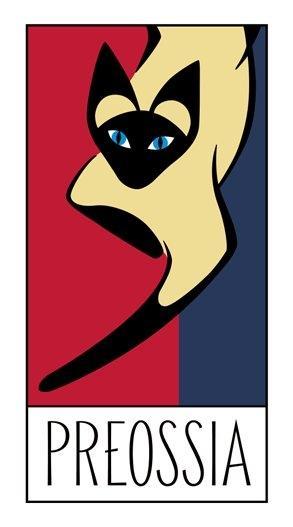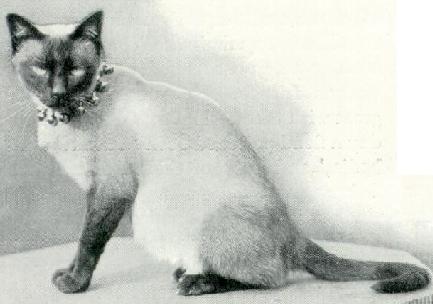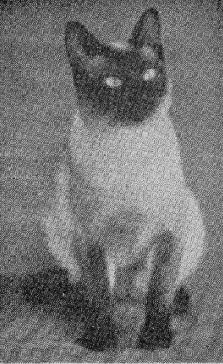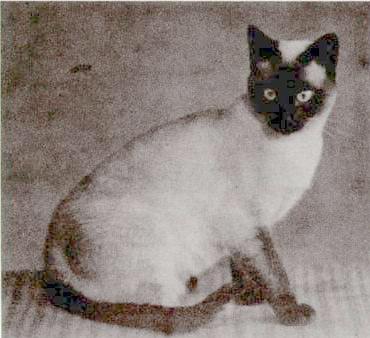 |
Official Standard for the Old-Style Siamese: The TICA Thai Breed Standard
The following is the official show standard for the breed known as "Thai" in TICA. PREOSSIA has endorsed the TICA Thai standard as the standard for what has long been known as the Old-Style Siamese. It is a standard that was created through the joint efforts of a number of TICA judges, TICA officers, TICA committee members, and Old-Style Siamese/Thai breeders in Europe and North America.
|
THAI (TH)
HEAD 40 points
__Shape
10
__Forehead
5
__Profile and nose
5
__Eyes
4
__Eye color
3
__Ears
4
__Muzzle and chin
7
__Neck
2
BODY
35 points
__Torso
10
__Legs and feet
8
__Tail
5
__Boning
8
__Musculature
4
COAT/COLOR/PATTERN
25 points
__Texture and length
13
__Body color
12
CATEGORY: Pointed
DIVISIONS: Solid, tabby, tortie
COLORS: All
PERMISSIBLE OUTCROSSES: Siamese.
HEAD:
Shape: Modified wedge, medium width. Head is longer than wide, but not extreme or narrow. Upper head is laterally rounded; muzzle is wedge-shaped.
Forehead: Flat and long.
Profile/Nose: Nearly straight, but with a gentle convex curve just above the eyes and a very slight, gradual concave curve just below the eyes.
Eyes: Medium to slightly large, a very full almond shape, not oriental. Set slightly more than an eye width apart. A line from inner corner through outer corner of eye meets outer base of ear.
Eye Color: Blue. Deep blue shades preferred. Brilliance and luminosity are more important than depth of color.
Ears: Medium in size to slightly large, wide at the base, oval tips. The inner base of the ear is set above the center of the nearest eye. The ears point outward at an angle slightly closer to the top than side of the head (35 degrees from vertical). Allow for very light furnishings.
Muzzle: Medium long. Wedge-shaped: little or no muzzle break, with straight sides that taper to the nose. End of muzzle is slightly laterally rounded and medium-boned.
Chin: Neither weak nor too prominent, aligned vertically with the nose.
Neck: Medium length, neither thin nor overly muscular.
BODY:
Torso: Slightly to moderately long, lithe and graceful like a small panther. Well toned, but neither tubular nor compact. Underbelly is mostly level and parallel to the ground and firm. However, a slight amount of loose skin on the underbelly below the flank is permissible.
Legs: Medium length, graceful in form, but not coarse.
Feet: Oval shape; medium size in proportion to cat.
Tail: As long as the torso, tapering gradually to the tip.
Boning: Medium. Graceful. Neither refined nor coarse.
Musculature: Firm, but lithe, not meaty or dense. When picked up, cat weighs about as much as, or slightly more than, one would predict visually.
COAT/COLOR/PATTERN:
Texture: Silky; very little undercoat. Not a “painted on” coat, but definitely close-lying.
Length: Very short to short.
Body Color: Preferably a very pale off-white that is imbued with a faint trace of the point color of the cat. Evenness of the body color and contrast with the points are more important than extreme whiteness.
Point Color: Appropriate for color class, dense and even. Mask, ears, feet and tail should match in color.
GENERAL DESCRIPTION:
The ideal cat of this breed is a medium to slightly large, pointed cat of foreign type, descended from and resembling the indigenous pointed cats of Thailand. The Thai is intended to be both the living equivalent of the original “Wichien-maat” of ancient Siam and the “marten-faced” Siamese of early 20th century America and Europe.
It cannot be stated enough that the Thai should not be extreme in any way, but its appearance and personality should reflect its Thailand heritage. The Thai is not, and should not resemble, a native Western breed.
The breed began in the 1950s when breeders scattered around the world chose to breed, or sometimes unwittinginly continued to breed, Siamese of the moderate, early 20th century type. In the 1980s, the first breed clubs dedicated to these cats were established in the United States and Europe. In 2001, breeders began importing indigenous pointed cats from Thailand in a conscious effort to expand and preserve a healthy gene pool for the Thai breed as well as to preserve the genes of Southeast Asia’s native race of cats while they are still distinct from Western cats.
The trademark of the Thai breed is the unique head shape, a laterally rounded upper head from which projects a distinctly wedge-shaped muzzle. In keeping with the Thai’s roots in tropical Thailand, another important feature is the breed’s very short coat, first clearly described in the West by Harrison Weir in 1889.
The Thai is a well balanced cat without any extremes, in harmony in appearance and character.
ALLOWANCE:
Incomplete point color and mask in kittens and young adults up to 12 months. Slight tabby markings on the body of lynx points as long as there is a good contrast to the points. Darker body shading in older cats as long as there is still a definite contrast between body and points. Stud jowls in males.
PENALIZE:
Genuinely round eyes. Extreme oriental eyes. Blunt or pointy muzzle. Narrow upper head. Small ears, very large ears, or ears set low (closer to the side of the head than the top). Compact body or distinctly tubular body. Whippy tail. Excess undercoat (plush coat). Ghost markings in non-agouti adult cats.
WITHHOLD WINS (WW):
Roman profile. Pronounced stop. Pronounced convex forehead. Distinct ear tufts. Fluffy fur with dense undercoat (“teddy bear” coat). Cobby body. Obesity. White lockets and buttons; white toes and feet (including paw pads); patches of white in the points. Eye color other than blue.
DISQUALIFICATION:
Visible tail fault. Crossed eyes. Visible protrusion of the cartilage at the end of the sternum (xiphoid process).
Temperament must be unchallenging; any sign of definite challenge shall disqualify. The cat may exhibit fear, seek to flee, or generally complain aloud but may not threaten to harm.
In accordance with Show Rules, ARTICLE SIXTEEN, the following shall be considered mandatory disqualifications: a cat that bites (216.9), a cat showing evidence of intent to deceive (216.10), adult whole male cats not having two descended testicles (216.11), cats with all or part of the tail missing , except as authorized by a board approved standard (216.12.1), cats with more than five toes on each front foot and four toes on each back foot, unless proved the result of an injury or as authorized by a board approved standard (216.12.2), visible or invisible tail faults if Board approved standard requires disqualification (216.12.4), crossed eyes if Board approved standard requires disqualification (216.12.4), crossed eyes if Board approved standard requires disqualification (216.12.5), total blindness (216.12.6), markedly smaller size, not in keeping with the breed (216.12.9), and depression of the sternum or unusually small diameter of the rib cage itself (216.12.11.1). See Show Rules, ARTICLE SIXTEEN for more comprehensive rules governing penalties and disqualifications.
|
|
|
|
Champion Bonzo, shown in both photos above, was the great great grandfather of Oriental Nanki Pooh of Newton. Nanki Pooh was imported into the U.S. and became literally the father of the American Siamese, breaking the record for the number of kittens sired by one stud. |
|
For questions about PREOSSIA, email the Webmaster.
(c) The Thai breed standard is copyright 2006 by The International Cat
Association. All other text and photos copyright
1999-2020 A.D. by PREOSSIA. Some photos and materials on or linked to this
site are copyrighted by individual PREOSSIA members and their friends and
are found here with their permission. You may link to this page, but may
not copy or reproduce any portion of it or anything linked to it without
written consent from the copyright holders.


